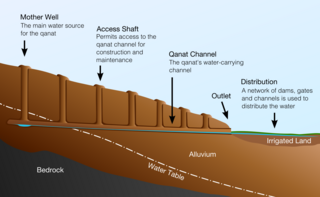On Qanats
Oliver Miles
Last year, a walker in the hills west of Guadalajara, Mexico came across a large hole that looked like the entrance to a railway tunnel. (The Mexican Guadalajara is named after the city in central Spain; the word is Arabic, meaning ‘valley of stones’.) He walked inside it a long way, noticing that every eleven metres there was a hole in the ceiling admitting sunlight. He had found a qanat.
Qanat (or qanah, probably derived from the Latin canalis) is the Arabic name for an irrigation system traditionally believed to have been invented in Persia, at least three thousand years ago. The Persian word is kariz and it has many other names: in Arabia falaj, in North Africa foggara.
To feed an oasis by underground water from a source that may be miles away, a well is dug to the source, and a tunnel is dug to channel the water to the oasis. Since the tunnel gradient is as little as 2° below the horizontal, the water reaches the oasis much higher up than the natural supply, as well as more abundantly, so the water is available to irrigate a larger area or to be used in other ways. Vertical shafts are dug along the line of the tunnel for ventilation, access and maintenance.
String plays a vital part in the construction. Obviously the vertical shafts have to be vertical, and this can be checked with a plumb line. The tunnel works best if it is straight, which can also be checked with a string. Less obviously, the exact gradient is critically important. For this a taut wet string is used; if the drips collect exactly halfway along, the two ends are at exactly the same level.
From Persia the system seems to have been imported into Arabia in pre-Islamic times; adopted and developed by the Romans; then probably taken by Arab conquerors into North Africa; from there to Spain; and by the Spaniards to Mexico, Peru and Chile. But it is also possible that the system was independently invented elsewhere, for example in south-eastern Arabia or pre-Columbian Peru.
A tribunal to settle irrigation disputes between farmers used to sit at the door of the main mosque in Valencia; it now sits at the door of the cathedral. Qanat systems exist in many other places: Italy, Sicily, Luxembourg (probably the largest north of the Alps), Central Asia, India. In Xinjiang, northwestern China, nearly a thousand qanats, with a combined length of about 5000 km, are currently in use in the Turpan oasis. Turpan, on the Northern Silk Road, is a Nationally Protected Area because of its water system – at least it was until quite recently, but since it is the home of the Uighurs, Turkic Muslims up to a million of whom are said to be detained and undergoing ‘re-education’, maintaining qanats may not be a top priority just now. There are some irrigation systems in Japan which may have come from China and therefore originally from Persia.
Some qanats have been listed as Unesco World Heritage sites. Many still function and some have been rehabilitated by various UN and other bodies. A typical qanat may be a few kilometres long, but one in Gonabad, southern Iran, is 45 km long and more than 360 m deep. There are said to be 37,000 qanats currently in use in Iran alone. Qanats can be used in conjunction with a wind tower to provide a natural form of air-conditioning, which can lower the air temperature in a house by as much as 15°C.
I was shown a qanat (falaj) in 1961 in one of the villages in al-Ain in Abu Dhabi by Shaikh Zayid bin Sultan, then the governor of al-Ain, later the ruler of Abu Dhabi and founding father of the United Arab Emirates. The channel was about as wide and deep as a household bath, and it was pleasant to bathe in it, tickled by the small fish. The temperature was much the same all the year round, refreshingly cool in summer and pleasantly warm in winter.

Comments